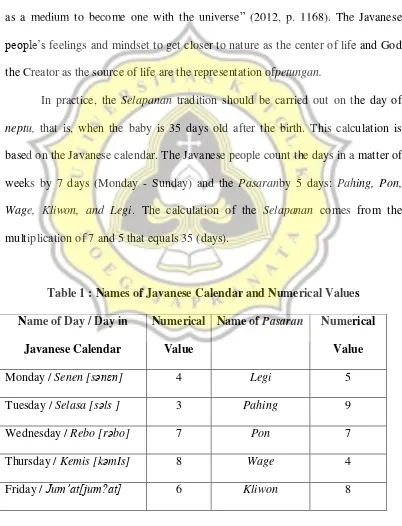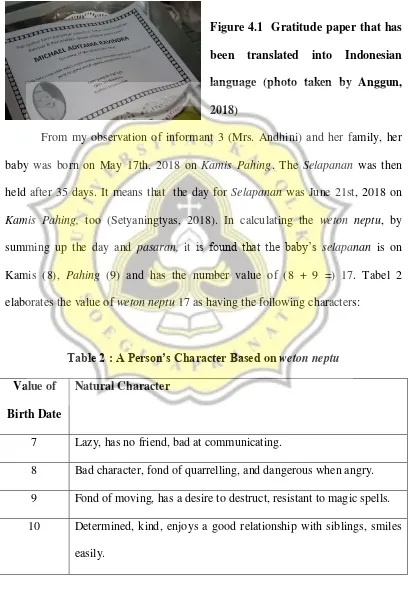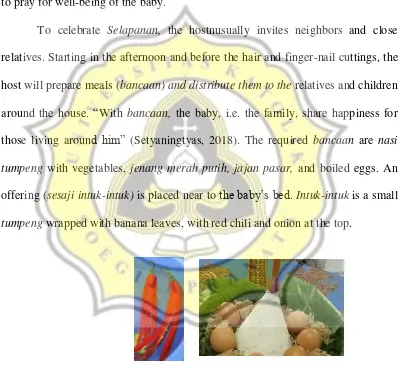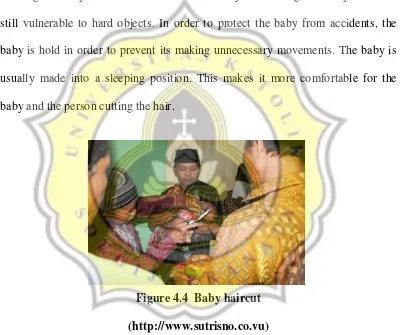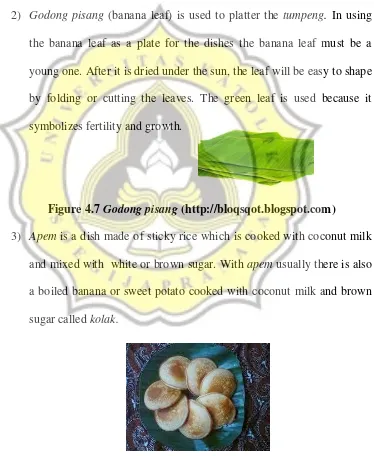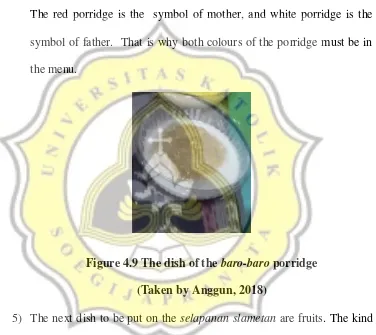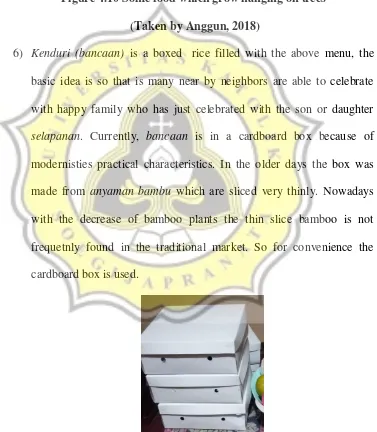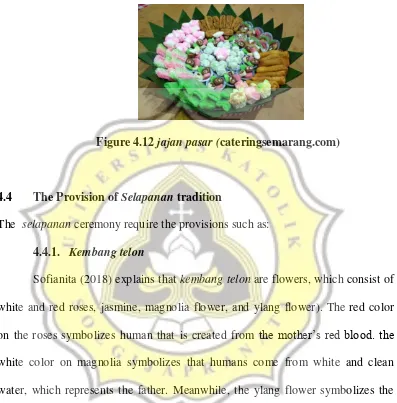15 CHAPTER IV
DATA ANALYSIS AND INTERPRETATION
This chapter attempts to discuss the values of Selapanan tradition based on Petungan and the reasons why the Javanese people in Kinibalu RW 02 Semarang
still manage to perform the tradition. The discussion is divided into 4 parts: 1) the calculation of petungan, 2) the procession of Selapanan tradition, 3) the meals of Selapanan, and 4) the provision of Selapanan tradition.
4.1. The Calculation of Petungan
In this part, the writer describes the Javanese called petungan. The data used in this research is a combination of those derived from written scholarly researches and from interviews with some informants believed to have a good knowledge of the Javanese petungan. From the data collected during the interviews, the writer discusses the people‟s perceptions of Selapanan tradition based on petungan. Selapanan in fact has to be prepared according to the established Javanese philosophy. In this case, the writer took a deep look into Selapanan perception, value and belief. This topic is highly interesting to be examined because every action performed and every thing presented yield particular meanings.
16
procession of Selapanan. What follows is the method of calculating the best day to hold Selapanan.
4.1.1. Petungan Selapanan based on neptu
According to Sahid and Kundharu, “the Javanese concept of petungan is the manifestation of a way of life, knowledge, and Javanese cosmology (kejawen) as a medium to become one with the universe” (2012, p. 1168). The Javanese people‟s feelings and mindset to get closer to nature as the center of life and God
the Creator as the source of life are the representation ofpetungan.
In practice, the Selapanan tradition should be carried out on the day of neptu, that is, when the baby is 35 days old after the birth. This calculation is based on the Javanese calendar. The Javanese people count the days in a matter of weeks by 7 days (Monday - Sunday) and the Pasaranby 5 days: Pahing, Pon, Wage, Kliwon, and Legi. The calculation of the Selapanan comes from the
multiplication of 7 and 5 that equals 35 (days).
17 Saturday / Setu [sətu] 9 Sunday / Minggu [minggu] 5
Source: (Soemodidjojo, 1994) cited from (Widodo & Saddhono, 2012, p. 1169)
Figure 4.1 Gratitude paper that has been translated into Indonesian language (photo taken by Anggun, elaborates the value of weton neptu 17 as having the following characters:
Table 2 : A Person’s Character Based on weton neptu
Value of Birth Date
Natural Character
7 Lazy, has no friend, bad at communicating.
8 Bad character, fond of quarrelling, and dangerous when angry. 9 Fond of moving, has a desire to destruct, resistant to magic spells. 10 Determined, kind, enjoys a good relationship with siblings, smiles
18
11 Generous, brave, smart, eager to steal if poor, trustworthy. 12 Accepts destiny, lucky, often loses things.
13 Talkative, peacefull, loves to be praised, high-tempered. 14 Work is not long-lasting, not rich, and shy.
15 Fond of giving orders, stubborn, enough to eat, a lot relatives, often fights.
16 Easy to forgive, fond of criticizing, his wish often comes true. 17 Failed ambitions, a quiet drifter, often treated badly by others. 18 Whiny, boastful when rich, likes being alone.
Source: (Soemodidjojo, 1994) cited from (Widodo & Saddhono, 2012, p. 1172)
Javanese people, especially the older generation, still believe that neptu and pasaran play important roles in determining a person‟s natural character. The characters of Mrs. Andhini‟s baby, based on his value of weton neptu 17, are: failed ambitions, a quiet drifter, and often treated badly by others. Based on primbon, those who have weton neptu Kamis Pahing are advisable to choose partners having weton neptu 7, 12, 17. The best potential partners of the baby are those born in weton neptu Sabtu Kliwon, Selasa Wage, Kamis Pahing, Selasa Pahing, Mingu Pon, Senin Kliwon, Rabu Legi, and Kamis Wage (Sugeng, 2013).
19
(Sofianita, 2018). Nowadays, the ceremony varies, and it depends on the prayer of every religion. It is usually the elder people who organize selapanan.
4.1.2. The Meaning of the Odd Number Symbol in Selapanan
Usually the amount and type of meals in slametan Selapanan are in an odd numbers. Javanese philosophy believe that odd formation is good (Satwikasanti, 2012, p. 31). “We have to choose odds; the dishes of slametan should be consumed by at least seven people (pitu) from word pitulungan, which means help and 11 (sewelas) from word kawelasan, which means mercy, 17 (pitulas) from word pitu and sewelas which mean help and mercy” (Suharsono, 2018). Odd numbers are believed to be lucky ones. Thus, the Javanese people adhere to the tradition in order to obtain salvation and luck. Salvation and luck are the important values in Javanese culture.
4.2. The Procession of Selapanan Tradition
The goal of Slametan selapanan is basically to safeguard the new mother, the baby and all members of the family (Mimin, 2004, p. 49). The purpose of selapanan is to pray for the baby that she/he will grow as a good person in the future, that the baby‟s safety is ensured, and the baby has a long life. The Javanese
20
Selapanan tradition in Kinibalu, RW 02, Semarang is still implemented because people believe that this tradition is an ancestral heritage that must be passed down to the younger generation. The living should preserve this tradition in order to get blessing. Refusing to practice this tradition might result in bringing disasters in present life. Therefore, Selapanan is always held by Javanese people from generation to generation. Selapanan ceremony in Mrs. Andhini family aims to pray for well-being of the baby.
To celebrate Selapanan, the hostnusually invites neighbors and close relatives. Starting in the afternoon and before the hair and finger-nail cuttings, the host will prepare meals (bancaan) and distribute them to the relatives and children around the house. “With bancaan, the baby, i.e. the family, share happiness for those living around him” (Setyaningtyas, 2018). The required bancaan are nasi tumpeng with vegetables, jenang merah putih, jajan pasar, and boiled eggs. An offering (sesaji intuk-intuk) is placed near to the baby‟s bed. Intuk-intuk is a small tumpeng wrapped with banana leaves, with red chili and onion at the top.
21
Figure 4.3 Selapanan situation (photo taken by Anggun, 2018)
According to Lies, when Selapanan is being carried out, verses of al-Quran known as seven surah i.e Surah Al Mulk, Ar Rohmah, Al Fatah, Kahfi Surah Maryam, Surah Yusuf, and Surat Waqiah are read (2018). Yet, in case of Mrs. Andhini family‟s Selapanan, they read bible, Mathew 1:1-16.18-23, instead. This because, they are Catholics (Setyaningtyas, 2018). It can be concluded that prayer in Selapanan is also varied based on the religion of the host. However, all share the common goal, that is, to pray for the safety of the baby.
4.2.1 Baby’s First Haircut/ Hair Shave
22
the baby will grow healthy in the future. The baby‟s hair should be cut or shaved completely clean. It is believed that the baby‟s original hair is already exposed to the amniotic fluid, so the baby hair must be haved off. Another reason for shaving the baby is so that the hair can grow healthier and nicelier in the future (Setyaningtyas, 2018). However, some people do not cut their baby‟s hair completely bald. The hairs are only trimmed for it is merely a symbolization. Shaving the baby‟s hair should be done carefully considering that baby‟s skull is still vulnerable to hard objects. In order to protect the baby from accidents, the baby is hold in order to prevent its making unnecessary movements. The baby is usually made into a sleeping position. This makes it more comfortable for the baby and the person cutting the hair.
Figure 4.4 Baby haircut (http://www.sutrisno.co.vu)
4.2.2 Cutting off Nails
Selapanan is an ancestral tradition and it is performed for the sake of the
baby‟s well-beings. Mrs. Andhini‟s family members are enthusiastic about
23
sharing bancaan. The main reason to hold it is to ensure the safety of the baby in life and afterlife. “We believe that if we fail to perform selapanan, disasters will happen in our our family, especially those related to the baby” (2018). After the haircutting, the next step is nail-cutting. The nail cutting seems to have hygienic purposes.
4.3. The Meals of Selapanan Tradition
In Javanese tradition, a child birth‟s ceremony or selapanan is commemorated in three stages, namely: first, when the new child is born, there is a thanksgiving ceremony on the birth of the baby or commonly called brokohan. Second, on the fifth day after the birth or called sepasaran, a kind of ceremony to express the happy feeling to God is done by distributing gudangan to nearby neighbors. Third, the selapanan ceremony is held when the baby is 35 days old. Javanese people are always full of consideration in doing something. They always try to balance their behavior wih nature, because they believe that with balance, their lives will run in harmony and dynamic.
24
1) Tumpeng is a dish made of white rice or yellow ricce with a various kind of vegetables and meat dish. If the rice is white it is call nasi gurih.
25
Figure 4.6 The dish of tumpeng (www.vemale.com/resep-makanan/112729
2) Godong pisang (banana leaf) is used to platter the tumpeng. In using the banana leaf as a plate for the dishes the banana leaf must be a young one. After it is dried under the sun, the leaf will be easy to shape by folding or cutting the leaves. The green leaf is used because it symbolizes fertility and growth.
Figure 4.7 Godong pisang (http://bloqsqot.blogspot.com)
3) Apem is a dish made of sticky rice which is cooked with coconut milk and mixed with white or brown sugar. With apem usually there is also a boiled banana or sweet potato cooked with coconut milk and brown sugar called kolak.
26
4) The next items in in selapanan menu is bubur merah and bubur putih that is called baro-baro porridge. In making the porridge there should be a combinatian at least one cup of rice mixed with one cup of water boiled with a sprinkle of salt this mixture strred until the rice became soft and watery. At this stage a quarter a cup of coconut milk is then added ontu it. For red porridge the mixture is added with brown sugar. The red porridge is the symbol of mother, and white porridge is the symbol of father. That is why both colours of the porridge must be in the menu.
Figure 4.9 The dish of the baro-baro porridge (Taken by Anggun, 2018)
27
Figure 4.10 Some food which grow hanging on trees (Taken by Anggun, 2018)
6) Kenduri (bancaan) is a boxed rice filled with the above menu, the basic idea is so that is many near by neighbors are able to celebrate with happy family who has just celebrated with the son or daughter selapanan. Currently, bancaan is in a cardboard box because of
modernisties practical characteristics. In the older days the box was made from anyaman bambu which are sliced very thinly. Nowadays with the decrease of bamboo plants the thin slice bamboo is not frequetnly found in the traditional market. So for convenience the cardboard box is used.
28
7) Jajan pasar is a menu made of different kinds of traditional snacks snacks. The variouty of jajanan pasar symbolizes the subtanance the baby in the future.
Figure 4.12 jajan pasar (cateringsemarang.com)
4.4 The Provision of Selapanan tradition
The selapanan ceremony require the provisions such as: 4.4.1. Kembang telon
Sofianita (2018) explains that kembang telon are flowers, which consist of white and red roses, jasmine, magnolia flower, and ylang flower). The red color on the roses symbolizes human that is created from the mother‟s red blood. the white color on magnolia symbolizes that humans come from white and clean water, which represents the father. Meanwhile, the ylang flower symbolizes the achievement, a child should be able to do in imitating the goodness an ancestor of the parents.
29 4.4.2. Kemenyan or incense
Kemenyan or incense is the media for sending prayers about the well being of the baby and its future. Simultaneously with the smoke rising up from burning the kemenyan, there is hope that the spirits will help and not disturb the baby (Suharsono, 2018).
Figure 4.14 kemenyan (benangmerahdasi.com)
